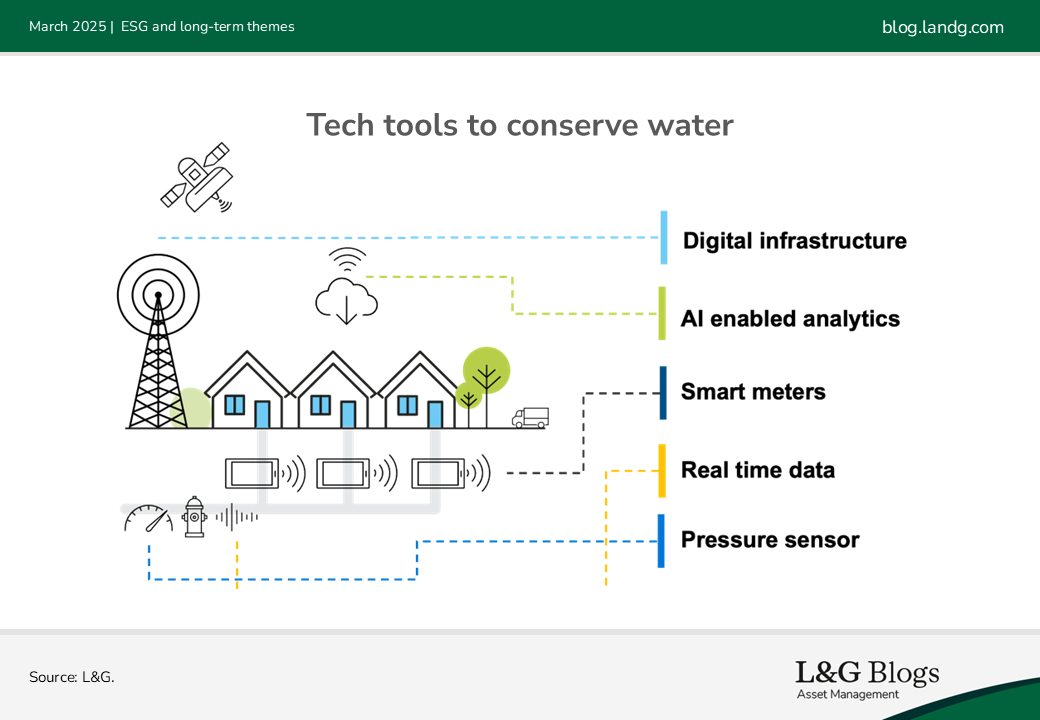Disclaimer: Views in this blog do not promote, and are not directly connected to any L&G product or service. Views are from a range of L&G investment professionals, may be specific to an author’s particular investment region or desk, and do not necessarily reflect the views of L&G. For investment professionals only.
Revolutionising smart water management with AI
AI’s water use is in the spotlight, but the same technology promises to transform how this most precious resource is managed, potentially leading to significant efficiency gains.

In our previous two blogs, we explored the knock-on effects of AI deployment on water demand and how water technology solution providers are addressing this challenge.
While AI and data centres are supporting demand for clean water, they are simultaneously driving innovations in digital water solutions, enabling more effective water usage across various sectors.
In combination with investment in ageing water infrastructure and stronger regulation and enforcement, new technologies could help address some of the most pressing challenges facing the water sector today.

New ways of saving water
Smart water management is being transformed by digital solutions that use cutting-edge technologies like sensors, AI and satellite imagery. These tools provide enhanced operational insights and support informed decision-making. By improving water quality, optimising water consumption and cutting operational costs, these solutions offer significant advantages to water utilities, industries and consumers.
In data centres, Ecolab* is working with Digital Realty to implement an AI-driven water solution that will reduce water use in its centres by 15%, avoiding the withdrawal of 126 million gallons of water from local watersheds annually.[1]
The integration of new technologies fosters more efficient and sustainable water management practices, promoting environmental health and resilience in water systems.
Some other key areas in which we are seeing AI benefits in water management are:
Predictive maintenance to prioritise key infrastructure upgrades
Ageing infrastructure will continue to deteriorate unless we adopt smarter management strategies. Predictive AI allows utilities to identify potential weak points swiftly, prioritise maintenance, and prevent failures before they happen.
For example, Itron, Inc.* and VODA.ai* are collaborating to simplify how water utilities identify and predict which pipe assets need to be replaced or rehabilitated, and which may contain harmful materials such as lead.[2]
Another example is Kurita*. This company’s water machine learning platform, Fracta, uses AI to predict leaks and detect them without any additional equipment installation, performing data cleaning and correction. With Fracta, leakage predictions in water distribution network are available in less than 45 days.[3]
Ensuring constant, clear water distribution
To maintain a constant, consistent supply of water, even when repairs are under way, AI algorithms can analyse flow data in real time and send insights to utilities, so that they can adjust water flow and pressure to minimise water losses and enhance network performance. Smart meters facilitate the efficient transmission of flow data, enabling more frequent meter readings.
Water quality monitoring for utilities
AI-powered sensors continuously monitor water quality in real time. These sensors detect changes in parameters such as pH levels, turbidity and the presence of contaminants. AI algorithms analyse this data to identify potential hazards and ensure that water remains safe for consumption.
Smart irrigation systems
AI-driven irrigation systems use data from weather forecasts and soil sensors to optimise watering schedules. This ensures that crops receive the right amount of water at the right time, improving agricultural efficiency and conserving water.
Facilitating global project planning
AI can assist in managing water resources more efficiently. By analysing data on water availability, usage patterns and population growth, AI algorithms can help authorities make informed decisions on water allocation and infrastructure planning, especially when navigating water scarcity.
Incorporating AI in industrial water treatment
Industries also benefit from incorporating AI into water treatment through real-time monitoring, remote controlling, predictive maintenance and process optimisation.
For further details on how transformative technologies could impact water companies and create potential opportunities for investors, please refer to our whitepaper.
*For illustrative purposes only. Reference to a particular security is on a historic basis and does not mean that the security is currently held or will be held within an L&G portfolio. The above information does not constitute a recommendation to buy or sell any security.
Sources
[1] Turning Water Challenges into Opportunities in 2025 | Ecolab
[2] Company announcement
[3] Company announcement
Recommended content for you
Learn more about our business
We are one of the world's largest asset managers, with capabilities across asset classes to meet our clients' objectives and a longstanding commitment to responsible investing.

